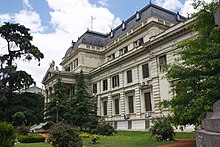Buenos Aires Province Chamber of Deputies
From Wikipedia, the free encyclopedia
The Chamber of Deputies of Buenos Aires Province (Spanish: Cámara de Diputados de la Provincia de Buenos Aires) is the lower house of the Legislature of Buenos Aires Province, the largest and most populous of Argentina's provinces. It is made up of 92 deputies elected in eight multi-member constituencies known as Electoral Sections. The number of deputies that correspond to each of the electoral sections is proportional to their population, as observed in the results of every nationwide census conducted in Argentina every 10 years. Seats may only be added to adjust the proportionality of each section, but never reduced.[1]
Chamber of Deputies of Buenos Aires Province Cámara de Diputados de la Provincia de Buenos Aires | |
|---|---|
 | |
| Type | |
| Type | |
| Leadership | |
President | |
Vice President | |
| Structure | |
| Seats | 92 |
 | |
Political groups | Government (36)
Opposition (56)
|
| Elections | |
Last election | 14 November 2021 |
| Meeting place | |
 | |
| Legislative Palace of the Province of Buenos Aires La Plata, Argentina | |
| Website | |
| http://www.hcdiputados-ba.gov.ar/ | |
As in the National Chamber of Deputies and most other provincial legislatures, elections to the Chamber are held every two years, so that half of its members are up in each election, making it a rare example of staggered elections used in a lower house.
The Chamber was established with the promulgation of the Constitution of the State of Buenos Aires, a short-lived secessionist state, in 1854. Its precursor, the Board of Representatives (Junta de Representantes) was established in 1820 as the province's first functioning legislative lower house. Originally located in the City of Buenos Aires, the provincial legislature was moved to La Plata following that city's establishment in 1882. The body meets in the Legislative Palace, designed by Hannover architects Gustav Heine and Georg Hagemann in 1883 and completed in 1888.[2]
Presidents of the Chamber
Summarize
Perspective
The President of the Chamber of Deputies is elected by the absolute majority of its members. The officeholders for this post since 1983 have been:[3][4]
| President | Party | Term start | Term end | Section | |
|---|---|---|---|---|---|
| Pascual Cappelleri | UCR | 10 December 1983 | 10 December 1987 | Third | |
| Luis Rodolfo Almar | UCR | 10 December 1987 | 10 December 1989 | Second | |
| Osvaldo Mércuri | PJ | 10 December 1989 | 10 December 1997 | Second | |
| Francisco José Ferro | UCR–Alliance | 10 December 1989 | 10 December 1997 | Seventh | |
| Alejandro Mosquera | UCR–Alliance | 10 December 1998 | 10 December 1999 | ||
| Francisco José Ferro | UCR–Alliance | 10 December 1999 | 10 December 2000 | Seventh | |
| Aldo San Pedro | PJ | 10 December 2000 | 10 December 2001 | Fourth | |
| Osvaldo Mércuri | PJ | 10 December 2001 | 10 December 2005 | Second | |
| Ismael Passaglia | FPV | 10 December 2005 | 10 December 2007 | Second | |
| Horacio Ramiro González | FPV | 10 December 2007 | 10 December 2015 | First | |
| Jorge Sarghini | FR–UNA | 10 December 2015 | 10 December 2016 | Capital | |
| Manuel Mosca | Cambiemos | 10 December 2016 | 10 December 2019 | Seventh | |
| Federico Otermín | FDT | 10 December 2019 | 10 December 2023 | Third | |
| Enrique Alejandro Dichiara | UP | 10 December 2023 | 20 December 2024 | Sixth | |
| Alexis Guerrera | UP | 20 December 2024 | incumbent | Fourth | |
References
External links
Wikiwand - on
Seamless Wikipedia browsing. On steroids.
